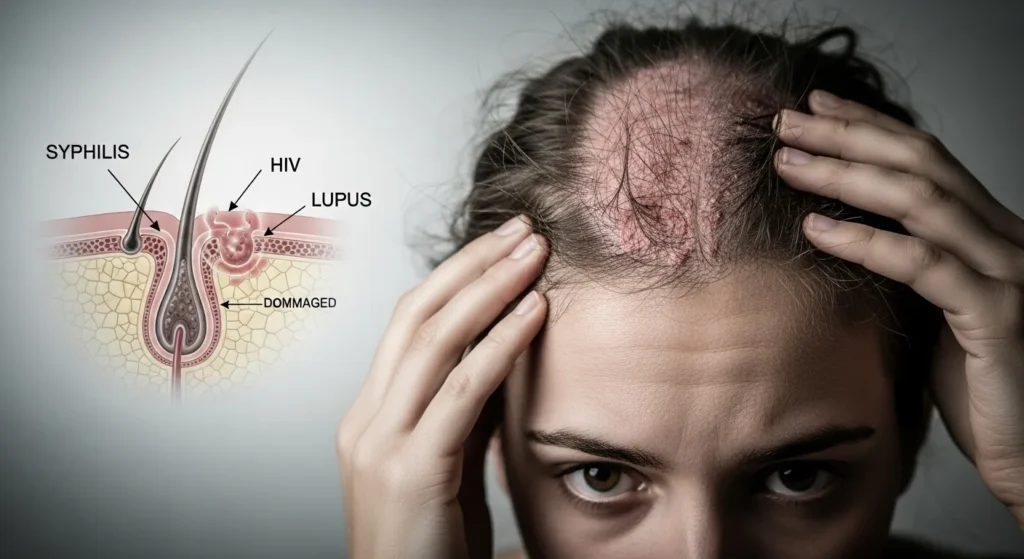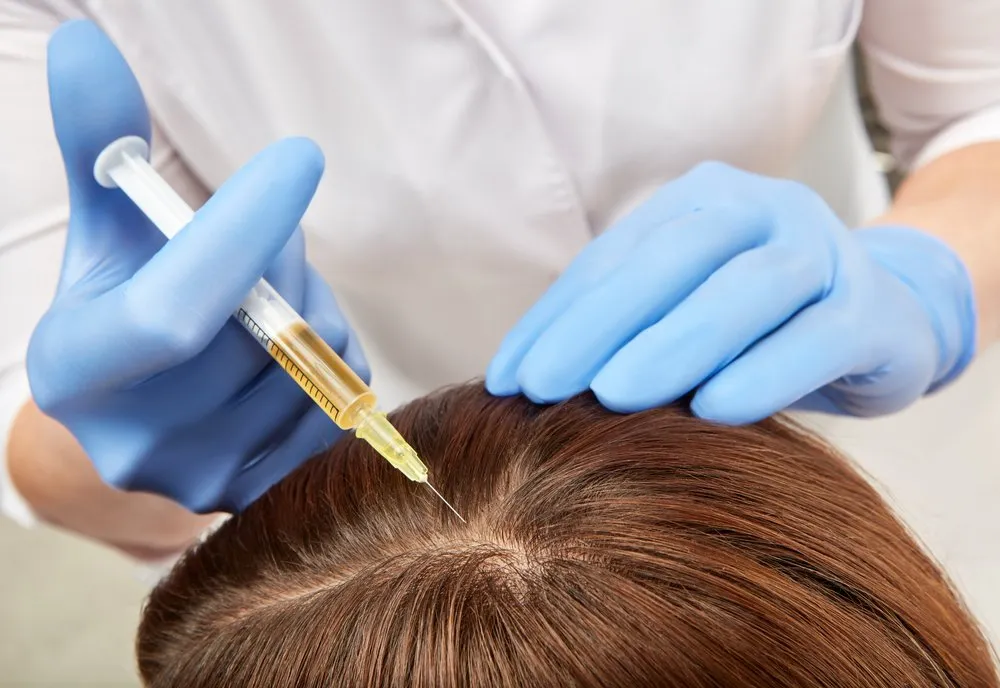Hair loss can be distressing, and when it’s sudden or unexplained, it raises even more concern. But what STD causes hair loss, and how do you know if your hair thinning is linked to a sexually transmitted infection?
In this article, we’ll explore the STDs most commonly associated with hair loss, including syphilis and HIV, and explain how these infections affect your scalp and follicles.
You’ll also learn about symptoms to watch for, treatment options, and when to seek expert help. With insights from medical professionals and real-life case studies, this guide is your trusted resource for clarity and recovery.
Can an STD Cause Hair Loss?

Understanding the Link Between STDs and Hair Health
Yes, certain sexually transmitted diseases (STDs) can contribute to hair loss. While not every STD leads to this symptom, some infections affect the body in ways that disrupt normal hair growth. This can happen due to inflammation, immune system changes, or the medications used in treatment.
Common Symptoms of STD-Related Hair Loss
Hair loss linked to STDs may appear as:
- Patchy or “moth-eaten” hair loss
- Thinning hair across the scalp
- Sudden hair shedding (telogen effluvium)
- Hair breakage, especially during combing or washing
These symptoms are often accompanied by other signs of infection, such as fever, fatigue, or skin rashes.
How Hair Loss From STDs Differs from Other Types
Unlike androgenetic alopecia (pattern baldness) or alopecia areata, STD-related hair loss is usually temporary and occurs due to underlying systemic stress or inflammation. Addressing the root infection can often stop further hair loss and even reverse it.
Which STDs Can Cause Hair Loss?
Syphilis
Syphilis is the most well-known STD linked to hair loss. In its secondary stage, it can cause “moth-eaten” alopecia, a patchy pattern of hair loss, especially on the scalp, eyebrows, and beard.
- It often appears months after the initial infection.
- Patients may also experience rash, sore throat, fever, and swollen lymph nodes.
- Treating syphilis with antibiotics like penicillin typically resolves the hair loss over time.
HIV/AIDS
Hair loss in HIV patients can occur due to:
- Immune suppression impacting hair follicle health
- Stress and nutritional deficiencies
- Antiretroviral therapy (ART) medications like Zidovudine, which may cause hair thinning as a side effect
It’s usually diffuse and resembles telogen effluvium—a condition where hair prematurely enters the shedding phase.
Herpes and Hair Loss – Is There a Connection?
Herpes itself is not directly linked to hair loss, but secondary stress or certain antiviral medications may contribute to shedding. Emotional stress and compromised immunity may trigger telogen effluvium in affected individuals.
Hepatitis B and C – Can They Lead to Hair Thinning?
Some cases of hepatitis C have been associated with hair loss, especially in patients undergoing interferon-based therapies. Hepatitis B has weaker evidence, but chronic illness and liver dysfunction can indirectly affect hair health.
How STD-Related Hair Loss Happens: Medical Explanation
Inflammatory Response and Follicle Damage
STDs like syphilis and HIV trigger systemic inflammation. This can disrupt the normal hair growth cycle, damaging hair follicles and pushing hair into the shedding phase.
Autoimmune Triggers From Infections
Infections may activate autoimmune responses. For example, the body might mistakenly attack its hair follicles, leading to forms of alopecia similar to alopecia areata.
Effects of Medications Used to Treat STDs on Hair
- Antiretrovirals and interferon therapies are known to cause hair thinning in some individuals.
- Antibiotics, while generally safe, can sometimes cause temporary telogen effluvium due to sudden physiological stress.
Diagnosis: How Do You Know if an STD is Causing Your Hair Loss?
When to Suspect an STD
You should consider an STD as a possible cause of hair loss if:
- You’ve had unprotected sex or multiple partners
- You notice other symptoms (rash, fatigue, weight loss, fever)
- The hair loss appears sudden and patchy
Medical Tests and Blood Work to Consider
- Syphilis: Rapid Plasma Reagin (RPR) test
- HIV: ELISA or antigen/antibody test
- CBC and liver function tests to assess systemic impact
- Thyroid and hormone panels to rule out other causes
Differential Diagnosis – Ruling Out Other Hair Loss Causes
A dermatologist may perform:
- Scalp examination and dermoscopy
- Scalp biopsy (if needed)
- Blood tests to exclude anemia, thyroid issues, or vitamin deficiencies
Can STD-Related Hair Loss Be Reversed?
Treating the Underlying Infection
In most cases, treating the STD stops further hair loss. For example:
- Syphilis hair loss resolves within weeks to months after penicillin treatment.
- HIV-related hair loss may improve with optimized ART and nutrition.
Nutritional and Lifestyle Support
Support your recovery with:
- Protein-rich diet
- Biotin and zinc supplements (under medical supervision)
- Stress reduction (meditation, therapy, etc.)
Medications and Therapies for Hair Regrowth
- Minoxidil (topical solution) to promote regrowth
- PRP therapy for post-inflammatory hair loss
- Microneedling or low-level laser therapy (LLLT) in select cases
Lessons Learned
- Timely diagnosis is critical.
- Hair loss often improves once the infection is treated.
- Combination care (medical + dermatological) leads to the best outcomes.
Preventing STD-Related Hair Loss
Safe Practices and Regular STD Screenings
- Use barrier protection (e.g., condoms) consistently.
- Get routine STD screenings every 6–12 months if sexually active with multiple partners.
Early Treatment to Minimize Hair Impact
Prompt STD treatment reduces the risk of long-term complications, including hair loss. Delayed care can worsen systemic damage.
Partner Communication and Prevention
- Talk openly with partners about testing and status.
- Encourage mutual STD testing before unprotected intimacy.
Medical References or Guidelines
- CDC: Syphilis and Hair Loss Documentation
- NIH: HIV Treatment Side Effects
- Mayo Clinic: Hair Loss Causes
Recovery Timeline After STD Treatment
| Infection | Hair Loss Type | Expected Recovery After Treatment |
|---|---|---|
| Syphilis | Patchy alopecia | 6–12 weeks |
| HIV | Diffuse thinning | 2–6 months with ART and hair care |
| Herpes | Rare, stress-related | 1–2 months post-outbreak |

When to See a Doctor: Red Flags You Shouldn’t Ignore
- Sudden or patchy hair loss
- Accompanying symptoms like rash, fever, and weight loss
- Unexplained fatigue or lymph node swelling
- Hair loss not improving after 2–3 months
Prompt evaluation can prevent further complications and improve outcomes.
FAQs About STDs and Hair Loss
Is hair loss a common symptom of all STDs?
No, only certain STDs like syphilis and HIV are known to cause hair loss, and even then, it’s not present in all cases.
Can hair loss be the only symptom of an STD?
In rare cases, yes—especially in early or latent syphilis. However, other symptoms usually appear soon after.
Are over-the-counter treatments effective?
They can help manage symptoms (e.g., minoxidil for regrowth) but won’t treat the underlying STD, which requires medical intervention.
Take Your Next Step
If you’re experiencing unexplained hair loss and suspect an underlying infection, don’t wait. Book a confidential consultation with Dr. Rana Irfan in Islamabad for:
- Comprehensive STD-related hair loss evaluation
- Lab testing and diagnosis
- Personalized treatment plans, including medical therapy and hair restoration options
